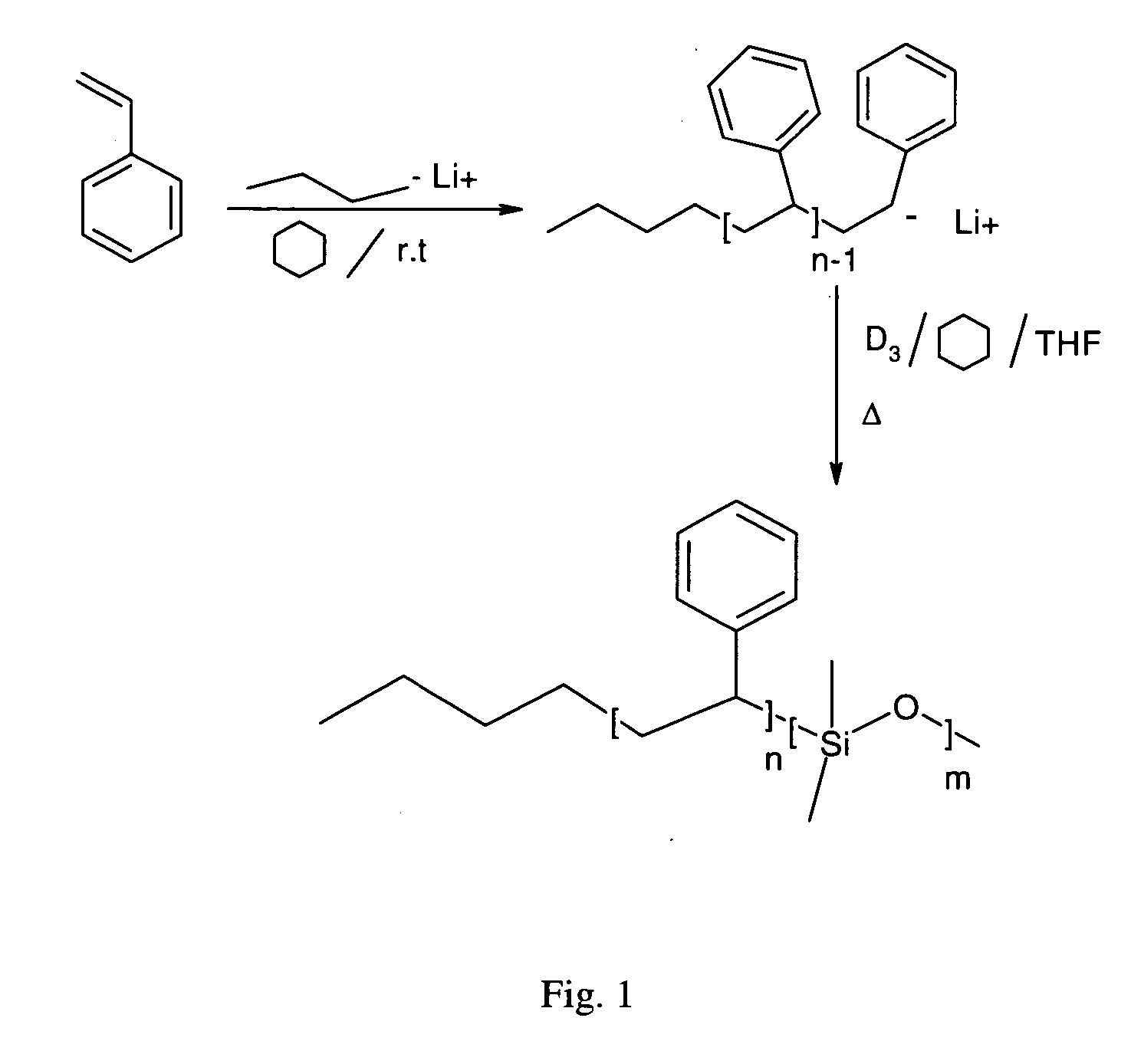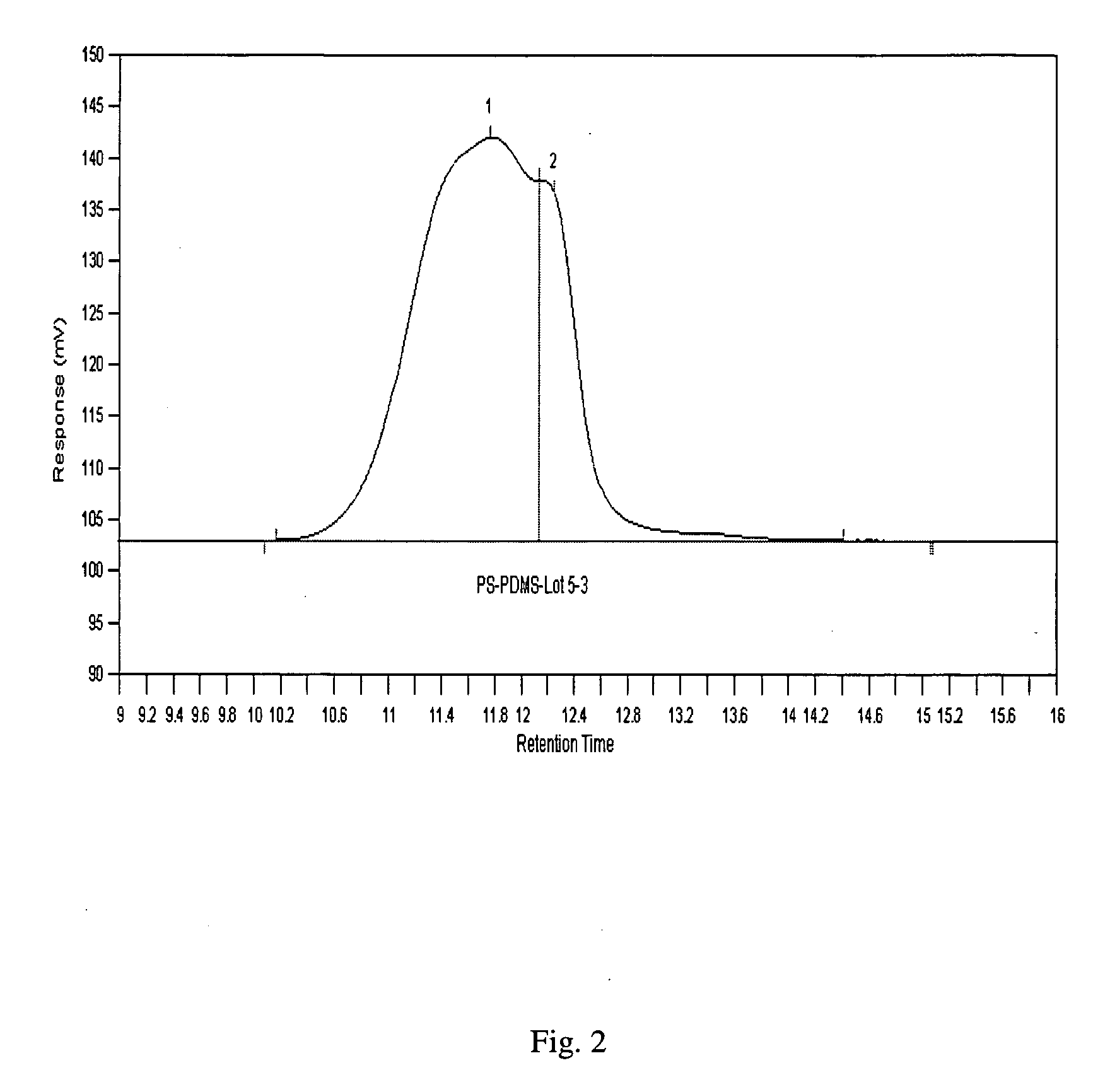Superhydrophobic fibers and methods of preparation and use thereof
- Summary
- Abstract
- Description
- Claims
- Application Information
AI Technical Summary
Benefits of technology
Problems solved by technology
Method used
Image
Examples
examples
Preparation and Measurement of Electrospun Fibers
[0086] A Poly(styrene-co-dimethylsiloxane) diblock copolymer was synthesized at Dow Corning Corp. laboratories by sequential controlled anionic polymerization of styrene and then hexamethylcyclotrisiloxane (D3) as shown in FIG. 1 [Rosati, D.; Perrin, M.; Navard, P.; Harabagiu, V.; Pinteala, M.; Simionescu, B. C. Macromolecules, 1998, 31, 4301; Pantazis, D.; Chalari, I.; Hadjichristidis, N. Macromolecules, 2003, 36, 3783]. All operations were carried out in a Schlenk line operating under a vacuum pump and dry nitrogen or argon.
[0087] The size exclusion chromatography (SEC) chromatogram of PS-PDMS is shown in FIG. 2. Peak 1 was identified as the copolymer with Mn=238000, polydispersity (pdi)=1.16, and accounts for 76.6% of the sample. Peak 2 was identified as residual PS homopolymer, Mn=114000, and accounts for the remaining 23.4%. Assuming that the Mn of the PS block in the copolymer is also 114 k, the composition of the copolymer is...
example 2
Characterization of the Electrospun Fibers
[0101]FIG. 4 shows typical SEM pictures of the fibers produced according to embodiments of the invention. The fiber diameter ranges from 150 to 400 nm. Besides the broad distribution of fiber diameter, “beading” on the fibers was also observed, but was generally minor, as demonstrated in FIG. 4. According to embodiments of the invention this “beading” might be due to the insufficiently fast stretching during the whipping and the heterogeneity of the microphase-separated solution.
[0102]FIG. 5 shows TEM images of the as-electrospun PS-PDMS fibers. The dark regions are associated with the higher electron density of the PDMS blocks. According to embodiments of the invention, judging from the longitudinal striations in FIGS. 5 (a) and (b) and the dark circular objects observed on the cross-section images in FIGS. 5 (c) and (d), the fibers appear to be comprised of PDMS cylinders with a diameter of about 20 nm dispersed in the PS matrix, consist...
example 3
Superhydrophobic Fiber Mats Prepared from Various Copolymers
[0108] Table 2 presents the composition and conditions for the preparation of additional electrospun superhydrophobic fibers. A number of additional fibers and mats comprising the same were produced using various copolymers, which yielded a water contact angle of above 150°.
ContactSample#Parts#Parts% ttlangleNo.CopolymerCopolResinresinsolidsSolventof mat1PS-DMS of Ex. #118MQ siloxane 5233:1 THF-167.9resin (DowDMFCorning 407)2PS-DMS of Ex. #115MQ siloxane10253:1 THF-168.9resin (DowDMFCorning 407)3PS-DMS of Ex. #112MQ siloxane12243:1 THF-168.5resin (DowDMFCorning 407)4PS-DMS of Ex. #1———12.95% weightChloroform170.5solution5PS-PDMS———9% weight4:1168MW: 153,000, PSsolutionchloroform-Volume ratio of 0.813DMFmixture6Poly(dimethyl siloxane)———15% weightChloroform157.8Etherimide: 35-40%solutionpolydimethylsiloxane
[0109] Some embodiments of mats were prepared, as described hereinabove, via electrospinning of a polystyrene-polydim...
PUM
| Property | Measurement | Unit |
|---|---|---|
| Fraction | aaaaa | aaaaa |
| Pore size | aaaaa | aaaaa |
| Angle | aaaaa | aaaaa |
Abstract
Description
Claims
Application Information
 Login to View More
Login to View More - R&D
- Intellectual Property
- Life Sciences
- Materials
- Tech Scout
- Unparalleled Data Quality
- Higher Quality Content
- 60% Fewer Hallucinations
Browse by: Latest US Patents, China's latest patents, Technical Efficacy Thesaurus, Application Domain, Technology Topic, Popular Technical Reports.
© 2025 PatSnap. All rights reserved.Legal|Privacy policy|Modern Slavery Act Transparency Statement|Sitemap|About US| Contact US: help@patsnap.com



